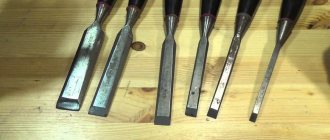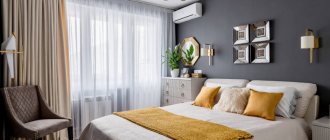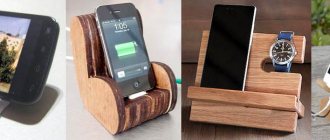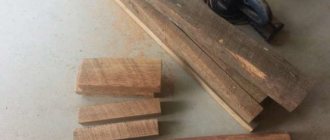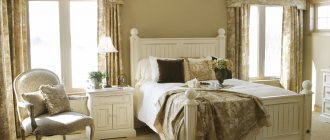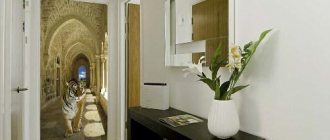What is MDF
First, it’s worth understanding what MDF is. Translated from English, the abbreviation “MDF” translates as “medium density fiberboard.” This material is made from wood fibers.
MDF production includes the following stages:
- Sawdust is crushed to a powder state. To do this, the raw materials are brought to 100 degrees temperature and 80 percent humidity. And then it is ground in a defibrator.
- Then urea-formaldehyde resins and paraffin are added to the powder. The mass is thoroughly mixed and dried at a temperature of 200 degrees. By the way, the mixture dries within a few seconds.
- The resulting mass is transferred to a hopper and compacted, and then rolled out with a roller along a conveyor. This creates a slab.
- It is fed to the press, and under a pressure of 350 MPa and when heated to 230 degrees, the pressing stage goes through. After this, the pressure decreases three times and the process of adjusting the thickness of the plate takes place without high temperatures.
- The cooled slab is sanded and cut into pieces of the required size.
If you cannot find special paint for MDF, you can use painting compounds for windows and doors, or for wood.
Fiberboard is one of the most commonly used materials in the furniture industry. And this is no coincidence. MDF has enough advantages:
- Moisture resistance;
- Strength;
- Availability;
- Long service life;
- Possibility of creating various reliefs and decor;
- Resistance to temperature changes;
- Wide range of applications.
You can paint the furniture yourself.
Often, happy owners of MDF furniture believe that it is impossible to repaint such interior items with their own hands. But in vain. Everything is much simpler than it might seem at first glance. The main thing is to choose the right paints, namely:
- Primer compositions;
- Paints with high hiding power and wear resistance;
- Varnishes or polishing kits.
With a wide range of colors to choose from, you are sure to find something that suits you.
By painting MDF surfaces, you will refresh the interior, extend the service life of products and significantly improve performance. The latter is especially true if you decide to update the furniture in the bathroom or kitchen.
Choose quality paint manufacturers.
However, there are also disadvantages to coloring. Firstly, it will cost you much more than covering the facades with decorative film. And, secondly, painted surfaces fade over time.
Modern technology for painting MDF panels
Painting of surfaces made from MDF is done not only for decorative, but also for protective purposes. The main advantages of painting panels yourself:
- The coating is resistant to elevated temperatures, which allows you to place even hot dishes on the kitchen surface.
- High-quality painting of MDF with enamel allows you to make the facade more refined and original, giving it a unique design. For example, you can decorate your furniture with interesting decor in the form of pearls, mother-of-pearl, metallic and so on. To achieve this, various fillers are added to the paint.
- Safety for health, since only high-quality paints and varnishes are used.
Painted MDF panels not only look better, but are also more reliable and durable.
Disadvantages of painting MDF panels:
- higher price compared to film coating;
- If you use low-quality paint, over time the painted facade may fade under the influence of sunlight.
Correct and high-quality painting must be carried out in compliance with all the rules of the technological process. For the job you will need paint, wood primer or polyurethane primer, and varnish.
In order for a painted facade to look beautiful and not deteriorate over time, certain temperature conditions must be observed. It is best if all processes take place at a temperature of about twenty degrees. At the same time, air humidity should be in the range from 50 to 80 percent. The humidity of wood wall panels should be 8-15%.
Before applying paints and varnishes, they must be filtered using a 50-100 micron filter. It is advisable to filter twice if the paint has been stored for more than two weeks.
Preparation
As with any task, preparation plays a very important role in the process of painting furniture at home. First of all, the furniture is disassembled before painting. At least take the doors off their hinges. Thanks to this, the process of applying paint will become more convenient, and parts that do not need to be painted will be protected from the ingress of paint.
Take a responsible approach to the process of preparing furniture.
Working surfaces are thoroughly washed and degreased. This is done using an aqueous solution of dishwashing liquid, vodka (or alcohol). Then, using a special wood putty, chips and cracks are removed.
Materials and tools needed for painting
First of all, decide on the choice of paint
Before the technology for painting MDF facades is considered, it is necessary to select and purchase all the tools and materials necessary for the work so as not to be distracted later by searching for them.
The first step is to decide on the paint color. You can choose a suitable shade according to the manufacturer's catalog or create your own by mixing several paints, the main thing is that paints from the same manufacturer are used for mixing.
Paint for MDF facades must have moisture-proof and heat-resistant characteristics, it must be durable, strong and not susceptible to mechanical stress. The best choice may be alkyd paints or auto enamels.
After the selection and purchase of paint has been made, you need to ensure that you have the other necessary materials and tools, such as:
- Primer;
- Roller;
- Brushes;
- Gloves;
- Sandpaper;
- Masking tape.
Grinding
In order for the coloring composition to lay down in an even layer and form reliable adhesion to the surface, the area of future painting is sanded. For processing a small area, ordinary sandpaper is suitable, but if you have to do global sanding of large surfaces, it is better to use a sanding machine.
Use special materials for sanding MDF.
To ensure that the puttyed chips and cracks take the shape you want, use a special abrasive mesh.
Attention! While operating the grinder, do not allow the working surfaces to overheat.
After sanding, the dust is removed with a vacuum cleaner, and then the surface is treated with a solvent.
Use paint remover.
The effectiveness of this treatment is noticeable visually and to the touch: the treated areas become matte and rough.
Painting stages
At the preparatory stage, you need to pay great attention to the processing of the slab. To treat the surface to a glossy finish, you need to avoid raising the pile and eliminating embossing that occurred during the production process.
The MDF facade should be milled at maximum speed, which will avoid raising the pile. Since the paint layer here is very thin, it is advisable not to leave sharp corners that can be easily knocked off. For cutting corners, it is best to use an edge cutter with a radius of about 3 mm.
To properly sand the MDF facade, it is necessary to remove the surface protective wax layer from the entire surface. An eccentric type grinder is best suited for this work. To process complex curves, it is advisable to use sandpaper. If you plan to paint MDF wall surfaces that include several component elements, then it is better to properly fill the joint gaps with a primer to fill the pores.
Primer
Now you can start priming. This stage is considered one of the most important. The final result of all your work on painting MDF furniture depends on its high-quality execution.
Choose a quality primer.
The correctly selected composition copes with the following tasks:
- Provides reliable adhesion of paint to the surface being treated;
- Increases the strength of the top layer;
- Masks minor defects;
- Prevents the rise of pile on the surface of MDF;
- Reduces paint consumption due to reduced absorption.
High-quality staining will improve the appearance of the furniture.
Most often, a two-component polyurethane or water-dispersion primer is used for MDF. The process itself takes place in two stages:
- First, the end and protruding elements are primed, and then the entire surface. After the first layer has dried, raised fibers and other defects are removed using a sanding sponge. But they do this extremely carefully so as not to damage the primer layer to the base.
- The dust formed after grinding is removed from the surface and primed again. White polyurethane primer is applied at the rate of 150 grams per 1 square meter. m. Leave until completely dry (usually this takes from 8 to 24 hours). The dried surface is treated with a Scotch-Brite sanding sheet.
A special device will help you quickly paint MDF.
Decorating painted furniture
When painting MDF products, it is not at all necessary to limit yourself to applying varnish. To breathe new life into a familiar interior, you can resort to decoration. There are many ways to decorate painted surfaces:
- Artificial aging. To imitate antiquity, special patination compounds are required. With their help, emphasis is placed on individual elements: frames, plinth, parts with cutters.
- Decoupage. A design is attached to the product (for example, cut out of a paper napkin) and varnished. Most often, this decorative option is used in interiors designed in Provence style.
- Application of patterns and drawings. Products are decorated using ready-made or self-made stencils.
- Decorative flaws. Irregularities, chaotically located strokes, bubbles, and dents are created. They often resort to the following technique: they apply glisal, after which they create fancy embossing on it with sponges, brushes, seals, textured rollers, etc.
- Decoration with rhinestones, crystals, stones and other decorative elements. Handles or other small details are decorated in this way.
- Glaze. Using this technique, beautiful deep iridescent shades are achieved. This effect is achieved by applying a translucent composition over the base color.
- Raindrops. This decor option involves the use of 2 colors. First, apply a rich shade product. After it hardens, water is sprayed from a spray bottle onto the work surface. Without waiting for it to dry, paint of a different color is applied on top using a light spray technique. After the paint composition has completely dried, the area to be decorated is sanded and varnished.
I hope the recommendations outlined will help you achieve your plans. More information in the video below.
Types of paints
There are enough coloring compounds suitable for MDF, so you have the opportunity to choose both in composition and price.
- Alkyd. Valued for its ductility and strength. However, if furniture painted with such compositions is exposed to direct sunlight, the surface will quickly fade.
- Oily. Such paints are very demanding when it comes to primer.
- Water-based. Perhaps the easiest to use. They dissolve in water, dry very quickly, do not have an unpleasant odor and do not emit harmful substances. But this is where the advantages end, and as for performance characteristics, water-based emulsion “loses” to almost all other coloring compounds.
- Acrylic-silicone. Harmless, highly durable, helmets have only one drawback - their high price.
- Polyvinyl acetate. These paints are very demanding in terms of application technology. If you do not follow the recommendations, the paint from the surface begins to peel off.
Today you will find a variety of paint colors.
If you have the opportunity to use car paints, don't miss it. Automotive enamel forms a thin, opaque layer on the surface, and after drying it gives a beautiful gloss. This coating will serve you faithfully for many years.
You can constantly update the look of your furniture.
Advantages of MDF as a material for making facades
The photo shows a comparative description of the density of MDF and chipboard
MDF or Medium Density Fiberboard is a compressed board.
In the modern world, MDF is used in a wide variety of areas of life:
- Furniture manufacturing;
- Manufacturing of commercial equipment;
- Finishing of ceiling, external and internal wall surfaces.
Such a wide range of applications for this type of material is due to the fact that MDF sheets are endowed with many positive qualities:
- Withstands sudden temperature changes;
- They are moisture resistant and can be used in rooms with a humidity of 60-80%;
- They have a high level of strength and are able to withstand various loads;
- MDF boards are environmentally friendly and harmless to people and plants;
- High level of resistance to fungi, molds and microorganisms;
- MDF does not emit harmful fumes into the environment;
- The facade does not require modifications due to the high level of durability of the material;
- Furniture made from this material does not require any special measures to care for the surface;
- The structure of the material allows you to create a variety of interesting patterns on the façade using surface embossing, which expands the decorative capabilities of the material;
- MDF boards have an excellent level of sound insulation.
The consumer is also pleasantly surprised by the price of MDF boards, since it makes this unique material, or rather products made from it, accessible to everyone.
Technological process
The most convenient way to paint is with a spray gun. If you don’t have one and you can’t purchase such a unit (or simply don’t want to), use a roller. The main thing is that the roller has short pile. As a last resort, you can paint it with a brush, also with fine bristles. When purchasing, consult with the seller which roller (brush) to purchase, depending on the coloring composition that you plan to use.
The vast majority of experienced painters prefer to use spray paints. But such a solution has both strengths and weaknesses. The undeniable advantages include uniform application of the paint and varnish composition and, as a result, an excellent final result.
The end result will definitely please you.
Well, the main disadvantage is that nearby objects are necessarily painted without your consent. In other words, this method is quite “dirty”, and in order to avoid serious losses, it is recommended to paint in a separate room that you don’t mind getting dirty.
A spray bottle will help in painting furniture.
Be sure to paint in one direction. Usually two layers are enough. The main rule: each subsequent layer is applied only after the previous one has completely dried.
Changing the facade yourself not only saves money, but also allows you to make it as intended.
And work should be performed at a temperature of at least 15 degrees Celsius. To avoid poisoning by fumes, as well as to avoid paint getting on your skin or eyes, you should always wear protective glasses and gloves when working.
Photo: how to remake old furniture.
If you notice a defect in a painted area, eliminate it, sand the surface and carefully repaint with a cotton swab using light blotting movements. If a speck is found on a freshly painted façade, remove it using a sharp object, such as a knife.
View of an old product after restoration.
Most often, after painting, polishing of the product is required. The surface must be absolutely dry, there should be no dust or small debris on it, since any lint will be very noticeable in the light. If you are varnishing in several layers, remember that the first one should be the thinnest, and subsequent ones should be applied only after the previous one has completely dried.
You can choose to cover it with paint or varnish, and also decorate the sample using scrap materials.
After varnishing, the surface is sanded again. First, coarse-grained paper is used for this, and then fine-grained paper. To prevent pellets from appearing, the working surface is periodically moistened with water. A week after painting, polishing and sanding, the product is sanded again using an abrasive paste.
Don't throw away old furniture.
So, tired of furniture? Don't throw it away. It’s better to think about what bright color you can repaint a familiar interior element. And take action!
Improve your room design!
Perhaps you will find the painting process not only practical, but also exciting, and you will be happy to color other pieces of furniture.
Technology for painting furniture facades made of MDF
This is not an easy job, requiring painstaking skill, little skill and extreme care. Everything is done in several stages, and the final quality of painting depends on the quality of each of them. If you do not plan to paint the panels yourself, but want to call a specialist, then check the price per m2 in advance. If you do the work yourself, then study the steps in more detail.
Tools
You can use various tools to apply paint. The most basic thing is a brush, roller or spray gun. Everything directly depends on professionalism, budget and personal preferences. Remember that a more optimal result is achieved using a spray gun or spray gun. Using a spray gun you can not only paint, but also prime.
Two types of pistols have been developed: electric and pneumatic. The latter operate on the basis of air, which is pumped by a compressor, and the former from a regular electrical outlet.
If you purchase a brush or roller, then pay attention to the markings, which indicate what composition they should be used for.
The equipment for painting has been selected, now you need to select auxiliary materials. Among them: sanding pad (Scotch-brite), sandpaper of various grain sizes, solvent, markers, masking tape, anti-silicone and degreaser. Do not forget about personal protective equipment: gloves, work clothes and respiratory protection (respirator or cotton-gauze bandage).
The topmost layer on MDF is most often a glossy coating (paint or varnish). If it is not removed, the new layer will not be able to take hold. Therefore, the top must be treated with the coarsest sandpaper. It is not necessary to remove all the paint, the main thing is to make the surface rough.
The old coating can also be removed using special removers; if we are talking about acrylic paint, you can use a solvent.
Another option for surface preparation is a paint dryer (torch). It can be used for polyester coating. The varnish cracks under the influence of high temperature, and then it can be easily removed with a chisel or spatula.
We suggest you read: How to putty walls for painting, carrying out work from scratch to finishing
Grinding
To obtain a high-quality coating, you need a perfectly smooth surface. To obtain it, you must first grind the surface. Certain sanding steps require sandpaper of varying grits. P220-280 is used to prepare the base for primer, P320 is used to remove uneven ground, and P500 is sanding before applying paint.
For delicate and final sanding, use non-woven felt or Scotch Brite.
Painting
Painting MDF facades is not particularly difficult. When using a spray gun or gun, be sure to protect your respiratory tract. Keep the device at least 15 cm away from the façade. Please note that the movements should go in one direction so that the paint lays evenly.
If the technology is followed, the paint lays down smoothly and creates a perfectly flat surface. To make the tone deeper, you should apply another layer. Please note that if you are doing two layers, then the first one needs to be slightly disturbed with sandpaper so that the second layer is better secured.
Applying varnish
The varnish is usually applied in one layer, but more can be applied, but not more than three, to get a more concentrated result. Before applying varnish, the surface must dry thoroughly, which usually takes several days. The first layer is a light spray so that there are no drips for the next layer.
If you do the painting yourself, keep in mind that it is not advisable to do it outside, because dust or settled lint will be very noticeable in the light. Important: each layer of varnish needs time to dry - at least 10 minutes. If this requirement is met, you will get an ideal glossy facade with a mirror finish.
Final sanding of the facades using P500 sandpaper. Please note that the thinnest layer is always on the ends, which means sanding is done delicately. At the final stage, go over with Scotch Brite.
If desired, do some decorating. If you do the work at home, then use polishing, enamel, regular varnish or glazing. The latter is a translucent paint for the kitchen facade, which in appearance resembles marble stains. To do this, dilute it with water and apply in several layers.
What else do you need for DIY coloring?
By properly preparing a set of tools, you can prevent damage to parts of the headset during disassembly and assembly, and perform painting efficiently and quickly. For work you will need:
- screwdriver for dismantling facades, a set of screwdrivers of different profiles;
- set of brushes, roller, dye container;
- dye;
- if there are large chips and scratches on the facades - putty, spatula;
- primer composition corresponding to the dye;
- protective film;
- construction hair dryer - for removing the film coating from a chipboard product;
- fine and coarse sandpaper (sanding machine);
- solvent for removing grease stains.
For work you will need glasses, gloves, and overalls. Decorative elements are thought out in advance - you may need a stencil for drawing, paint of a different color, glue.
Painting tape is used to cover those parts of the facade that do not require painting; they need to be stocked in sufficient quantity.
During repainting, you can change the fittings - replace handles, hinges on doors, and poorly functioning opening mechanisms. It is better to choose elements that do not require making new holes on the headset. All hardware components are purchased in advance.
High-quality MDF painting based on your wishes
MDF facades are usually painted with two types of enamel: matte or glossy. Furniture facades have a standard 19 mm thickness, but we can paint front walls of other thicknesses (for example, 32, 16 and 10 mm).
Please note that facades and furniture parts can be painted on either one or both sides. Combined painting is possible (one side is matte, the other is glossy). Everything will depend on your wishes and preferences.
Glossy furniture facades are divided into two types: with deep milling and flat. They differ from each other in complexity and volume of work. Manufacturing MDF furniture facades with deep milling is a more complex technological process that requires more labor. The standard chamfer size is R-3 mm. Additionally, you can order sizes R-9 mm and R-6 mm.
